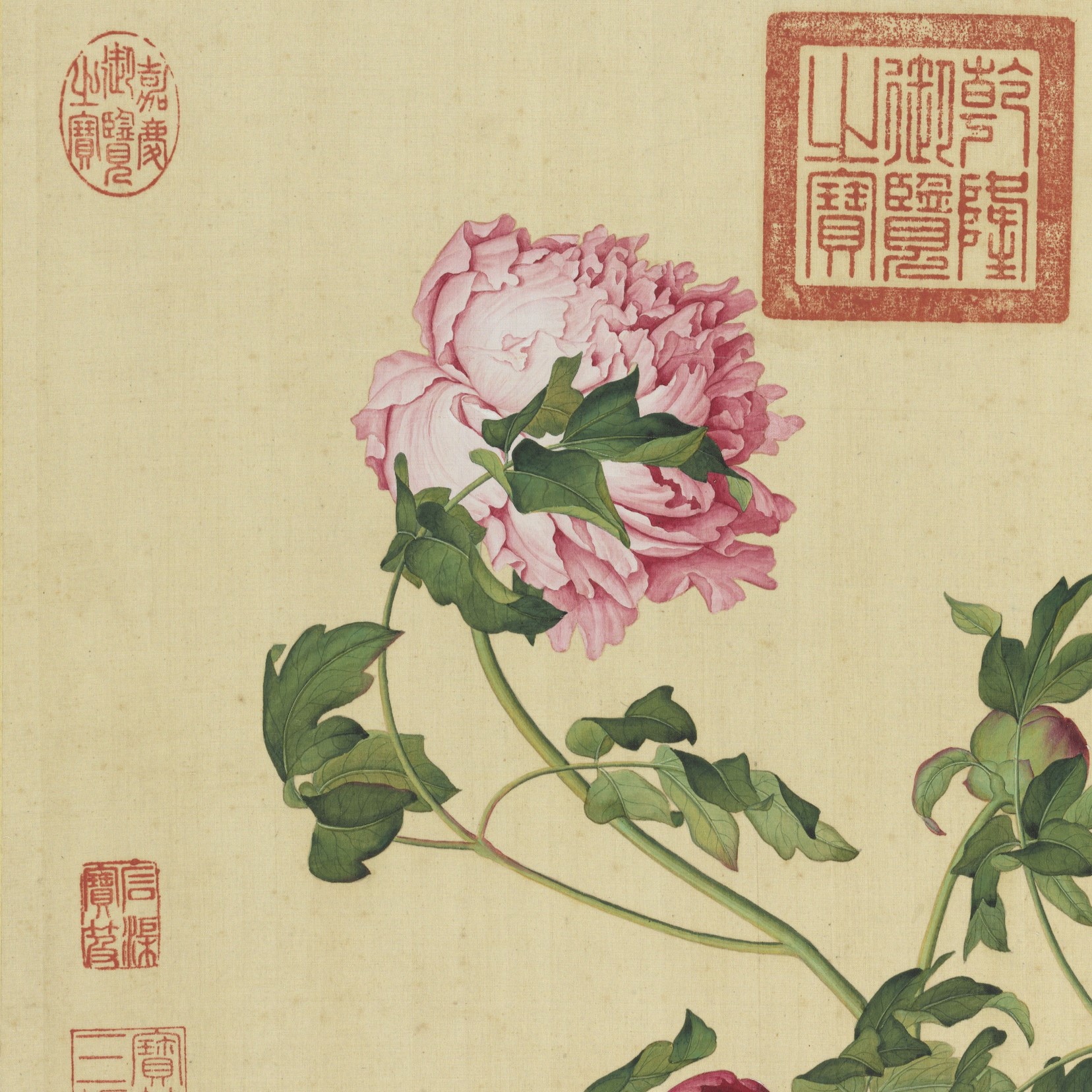Cultural Transmission through Auspicious Symbols in Lang Shining’s Flora Paintings
DOI:
https://doi.org/10.69598/sbjfa264875Keywords:
Auspicious Symbol, Chinese Arts , Lang Shining , Traditional Chinese PaintingAbstract
This article aims to study the cultural transmission through auspicious symbols in the flora painting collections of Lang Shining (郎世宁), an Italian artist who served as a court painter during the Golden Era of the Qing dynasty, from the reign of Kangxi, Yongzheng to Qianlong emperor. This qualitative research aims to study documentary research, e.g., academic papers and textbooks, including field notes. The fieldwork observes and collects Lang's Paintings information in the National Museum (Taipei). Afterward, the researcher organizes paintings by auspicious symbol themes to make the final comparative analysis between auspicious symbol themes related to Lang's paintings. The painting types, concepts, and auspicious beliefs in traditional Chinese paintings are studied by two flora paintings and a 16-piece "Immortal Blossoms of an Eternal Spring" set. The study revealed the auspicious belief grouping through Lang's flora painting as following concepts: 1) Heroic character with gracefulness and nobility; 2) Longavity or immortality; 3) Wealth; 4) Fertility or a perfect family; 5) Happiness or a prosperous life. Lang's flora paintings represented his skill in oil painting techniques with fine-brush style. This flower collection not only maintained Chinese stylistic brushwork incorporated with Western art of realism and composition but also abounded with auspicious signs of Chinese culture.
Downloads
References
พรพรรณ จันทโรนานนท์. (2549). ฮก ลก ซิ่ว โชคลาภ อายุยืน. (พิมพ์ครั้งที่ 4). มติชน.
ปิยะแสง จันทรวงศ์ไพศาล. (2552). 108 สัญลักษณ์จีน. ซีเอ็ดยูเคชั่น.
สุภาณี ปิยพสุนทรา. (2550). ร้อยเรียงเรื่องเล่าภาพมงคลจีน. สุขภาพใจ.
李祖定. (1988). 中国传统吉祥图案. 上海科学普及出版社.
郑军. (2005). 民间吉祥图案. 北京工艺美术出版社.
彩哥. (2020). 芍药的寓意. https://zhuanlan. zhihu.com /p/133309628#:~:text
花匠网. (2014, 七月 1). 花语大全. https://m. huajiang.cc/article/1281.html
花语. (2013, 六月 21). 海棠花的花语. https://www.hua.com/huayu/10965.html
_____. (2016a, 一月 5). 虞美人的花语. https://www.hua.com/huayu/13938.html
_____. (2016b, 三月 16). 蝴蝶花的花语. https://m.hua.com/huayu/15058.html
_____. (2016c, 六月 2). 黄刺玫的花语. https://m.hua.com/huayu/16141.html
_____. (2016d, 三月 7). 石竹花的花语. https://m.hua.com/huayu/14933.html
_____. (2015a, 十一月 26). 罂粟花的花语. https://www.hua.com/huayu/13430.html
_____. (2015b, 十二月 7). 牵牛花的花语. https://www.hua.com/huayu/13612.html
霍明琨. (2013). 说“吉祥”. https://epaper.gmw.cn/gmrb/html/2013-10/29/nw.D110000gmrb_20131029_2-13.htm
極客派. (2021). 燕子有什麼寓意,燕子象徵什麼?. https://www.jipai.cc/a/202103/266294.html
刘惠琳. (2020). 樱桃的花语是什么. https://wenda.huabaike.com/zwyh/57953.html
今日青年. (n.d.) 豆花的解釋. https://qjyouth.com/ci/2/13484.html
张都爱. (n.d.). 论美学意义上的“美”及其意义建构. http://philosophy. cupl.edu.cn/local/2/0C/73/E6E671425388172E8A420D761DD_155209C9_5E6EC.pdf?e=.pdf
Arnold, L. & Corsi, E. (2003). Of the Mind and the Eye: Jesuit Artists in the Forbidden City in the Seventeenth and Eighteenth Centuries. Wayback Machine Internet Archive. https://web.archive.org/web/20160826030536/http://www.ricci.usfca.edu/research/pacrimreport/prr27.pdf
Cai Ge. (2020). The meaning of peony. Zhuhu. https://zhuanlan.zhihu.com/p/133309628#:~:text
Chantarawongpaisarn, P. (2009). 108 Chinese Auspicious symbols. Se-Education. [in Thai]
Chantarojjananon, P. (2006). Hok Lok Siew Good luck long life. (4th ed). Matichon. [in Thai]
Hua Jiang. (2014, July 1). Huayu daquan: Flower language Encyclopedia. https://m.huajiang.cc/article/1281.html [in Chinese]
Huayu. (2013, June 21). Flower language of Malus spectabilis. Hua. https://www.hua.com/huayu/10965.html [in Chinese]
_____. (2016a, January 5). Flower language of Yu meiren. Hua. https://www.hua.com/huayu/13938.html [in Chinese]
_____. (2016b, March 16). Flower language of Hudie hua. Hua. https://www.hua.com/huayu/15058.html [in Chinese]
_____. (2016c, June 2). Flower language of Huang Ci Mei. Hua. https://www.hua.com/huayu/16141.html [in Chinese]
_____. (2016d, March 7). Flower language of Shizhu. Hua. https://www.hua.com/huayu/14933.html [in Chinese]
_____. (2015a, November 26). Flower language of Yingsu. Hua. https://www.hua.com/huayu/13430.html [in Chinese]
_____. (2015b, December 7). Flower language of Qian niu. Hua. https://www.hua.com/huayu/13612.html [in Chinese]
Huo, M. (2013). Say “auspicious”. Guanming Daily. https://epaper.gmw.cn/gmrb/html/2013-10/29/nw.D110000gmrb_20131029_2-13.htm [in Chinese]
Jípai. (2021). What does the swallow mean and what does the swallow symbolize?. https://www.jipai.cc/a/202103/266294.html [in Chinese]
Li, Z. (1988). Chinese Traditional Auspicious patterns. Popular Science Press. [in Chinese]
Liu, H. (2020). What is the flower language of Cherry?. Huabaike. https://wenda.huabaike.com/zwyh/57953.html [in Chinese]
National Palace Museum. (n.d.a). The Years Before and After Coming to China. https://theme.npm.edu.tw/exh104/giuseppecastiglione/en/page-2.html
_____. (n.d.b). Lang Shining Wurui Tu Axis. https://www.dpm.org.cn/collection/paint/230374.html
_____. (n.d.c). Yongzheng Reign (1723-1735): Immortal Blossoms in an Everlasting Spring. https://theme.npm.edu.tw/exh105/hongkong/en/page-3.html#main
Piyaphashuntra, S. (2007). One hundred tales Chinese Auspicious images. Sukaphabjai. [in Thai]
Qingjiao qingnian. (n.d.). Explanation of Douhua. QJYouth. https://www.qjyouth.com/ci/2/13484.html [in Chinese]
Shining, L. (1725). Gathering of Auspicious Signs [Online image]. National Palace Museum, Taiwan. https://theme.npm.edu.tw/exh104/giuseppecastiglione/en/page-2.html
_____. (1732). Lang Shining Wurui Tu Axis [Online image]. National Palace Museum, Taiwan. https://www.dpm.org.cn/collection/paint/230374.html
_____. (1735). Immortal Blossoms in an Everlasting Spring [Online image]. National Palace Museum, Taiwan. https://theme.npm.edu.tw/exh105/hongkong/en/page-3.html#main
Zheng, J. (2005). Folk Auspicious patterns. Beijing Arts and Crafts Press. [in Chinese]
Zhang, D. (n.d.). On the Beauty in Aesthetics and Its Construction of Meaning. http://philosophy.cupl.edu.cn/__local/2/0C/73/E6E671425388172E8A420D761DD_155209C9_5E6EC.pdf?e=.pdf [in Chinese]

Downloads
Published
How to Cite
Issue
Section
License
Copyright (c) 2023 © by the Author(s) & Silpa Bhirasri Journal of Fine Arts.

This work is licensed under a Creative Commons Attribution-NonCommercial-NoDerivatives 4.0 International License.
The journal's editorial team does not have to agree with the views and comments in the author's article, nor are they responsible for the comments.











